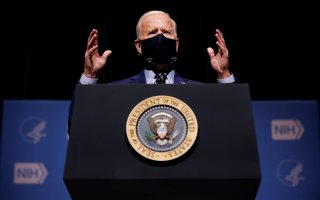How Many Jobs Will Democrats’ $1.9 Trillion Stimulus Plan Create?
For the sake of American workers and families, here’s hoping the Biden administration's optimistic projections are matched by reality.
Compared with the abundant attention focused on tens of millions of stimulus checks, enhanced unemployment benefits, and child allowances that Democrats’ $1.9 trillion American Rescue Plan would provide, the number of jobs that plan might create has gotten far shorter shrift.
That’s a significant — and apparently intentional — departure from the last Democrat-led stimulus. In January 2009, the incoming Obama-Biden administration touted a detailed report drafted by the new administration’s chief economists. That “Romer-Bernstein Report” confidently provided specific projections for what became the February 2009 stimulus law, suggesting it would quickly create millions of jobs and hold the unemployment rate under eight percent. Neither occurred.
In contrast, the closest the new Biden administration has come to offering similar projections is a brief February 3 White House blog post, which cites only the job-creation estimates of third parties:
First, Moody’s Analytics projects that the President’s Plan will bring the economy to full employment a full year earlier than a baseline without additional fiscal stimulus. This is significant because it’s a difference of 4 million jobs in 2021.
President Biden reinforced that message two days later, saying that “independent analysis” suggests the American Rescue Plan “could achieve…full employment by the beginning of next year.”
Recent projections by the nonpartisan Congressional Budget Office (CBO) provide the “baseline without additional fiscal stimulus” for job creation ahead. In a report issued on February 1, CBO projected 6.25 million net new jobs would be created between the fourth quarter of 2020 and the fourth quarter of 2021, or an average of 521,000 per month — again, without further stimulus. Adding 4 million jobs “in 2021” attributable to the president’s plan to that baseline of 6.25 million more jobs suggests the White House believes that, under their plan, payroll employment will be some 10.25 million higher at the end of 2021 than it was at the end of 2020. That would mean payroll employment would reach 152.9 million by the end of 2021. From January’s 142.6 million level, the economy would need to create between 900,000 and 1,000,000 jobs per month to meet that goal.
CBO also projected the unemployment rate would decline rapidly in the coming year even without another $1.9 trillion in stimulus. In their February 1 report, they forecast the unemployment rate would fall from an average of 6.8 percent in the fourth quarter of 2020 to 5.3 percent in the fourth quarter of 2021, which would be the most rapid one-year decline since 1983. While still above pre-pandemic levels, that 5.3 percent rate also would be below the average annual unemployment rate in most years (specifically, 43 of 78 years) since official data began being reported after World War II.
That’s without further stimulus. Meanwhile, a report by economists at the Brookings Institution, the other “independent analysis” cited by the president, estimates that with the $1.9 trillion plan “the unemployment rate would temporarily dip to 3.2 percent” in the period “from the fourth quarter of 2021 to the second quarter of 2022.” If that occurred, it would mark the lowest unemployment rate since 1953 and meet the president’s “full employment” pledge.
As the Ways and Means Committee began marking up the administration’s stimulus legislation Wednesday, Chairman Richard Neal (D-MA) repeated those “4 million jobs” and “full employment” projections for the president’s plan: “According to Moody’s, if we don’t act now, we could put 4 million jobs in jeopardy this year. Potentially pushing full employment even further out into next year.” For their part, committee Republicans have called on the administration to release its own projections for jobs and unemployment, instead of repeating the views of outside experts.
But even without a new “Romer Bernstein” style report, the fact is the administration and its allies in Congress already have issued their projections for jobs and unemployment under their $1.9 trillion plan. For the sake of American workers and families, here’s hoping those optimistic projections are matched by reality. But if reality falls short of nearly 1 million net new jobs per month and unemployment rates approaching historic lows in the coming year, the fact the administration relied on projections from third parties in selling their $1.9 trillion plan won’t make any difference.
This article first appeared on the American Enterprise Institute blog.
Image: Reuters

